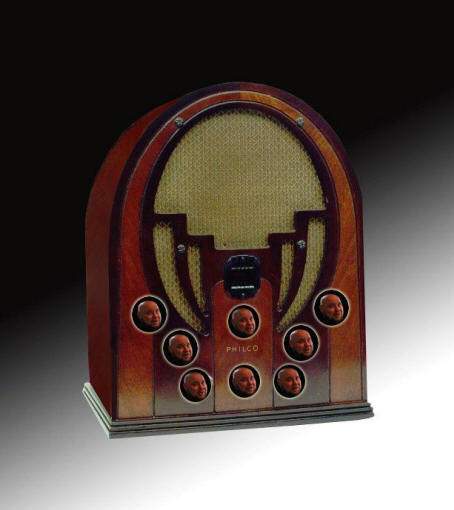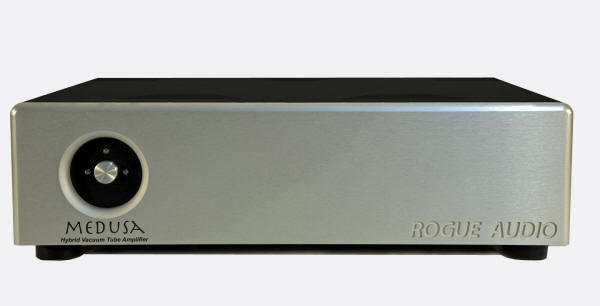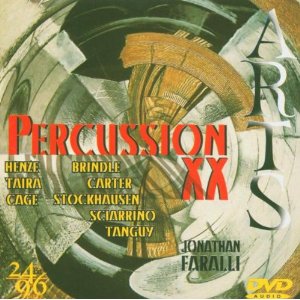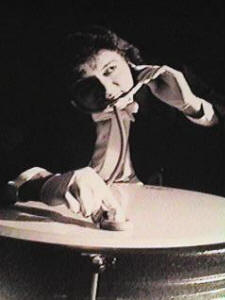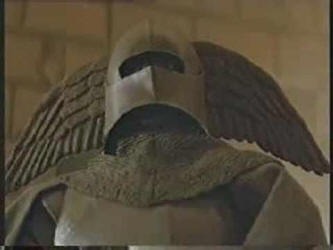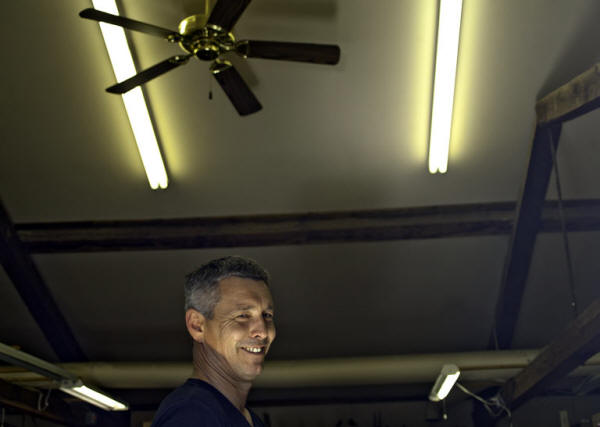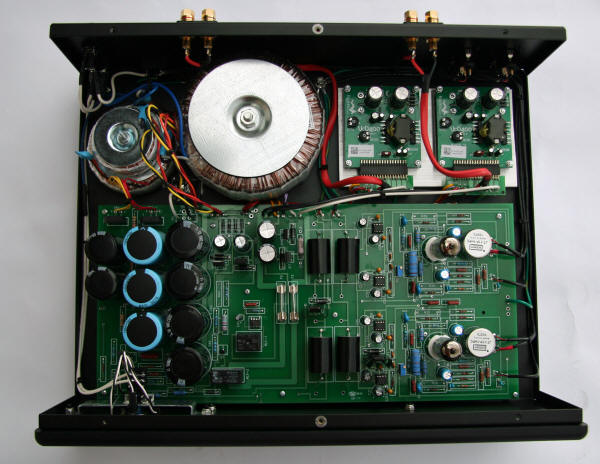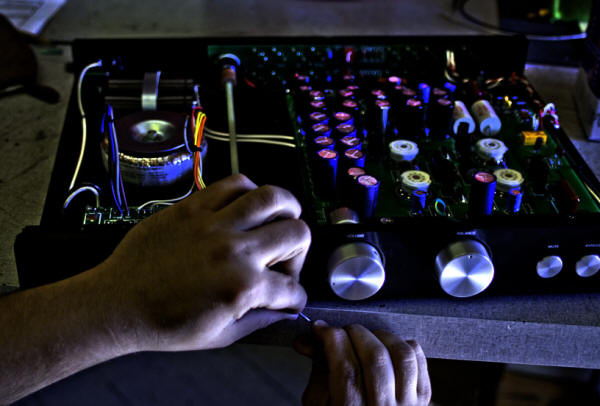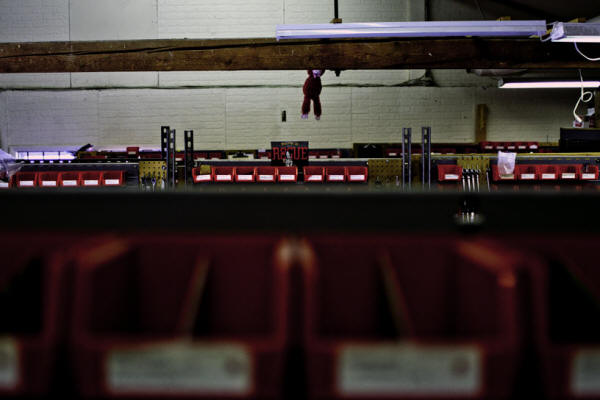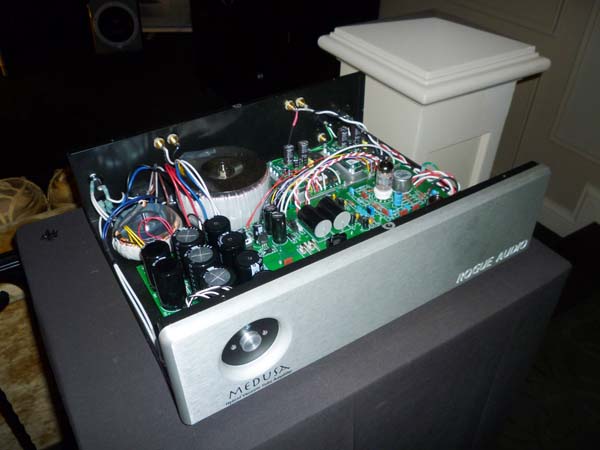|
You are reading the older HTML site
Positive Feedback ISSUE 60
Radio Free Chip:
Introducing the Rogue Medusa Hybrid Stereo
Amplifier… Plus an Exclusive Mark O'Brien Interview
We join your narrator in the midst of his initial audition: a bold new development from Rogue honcho and chief designer, Mark O'Brien—the Medusa Stereo Amplifier, a Class D-Hybrid design employing a dual-12AU7 front end and a MOS-FET back end, priced at $3995 and rated at 200 watts per channel into 8 ohms and 400 watts per channel into 4 ohms (their kid sister, the Hydra is priced at $2995 and rated at 100 watts per channel into 8 ohms and 200 watts into 4 ohms). As it so happens, my long-term reference loudspeakers are the Dynaudio Confidence C1, a remarkably full-bodied, high resolution pair of mini-monitors; while considerably more sensitive and efficient than some of the older Dynaudio designs, they nevertheless like power… and so do I. Because the Confidence C1 loudspeakers present a 4 ohm load to the Medusa, I am quite keen to hear what 400 watts per channel sounds like, and how this new hybrid design compares audibly with its mythological forbearers in the Rogue line (a series of All-Vacuum Tube amp and preamp designs, many of which reference the heroes and gods of Greek antiquity for their names, such as Rogue's flagship mono-blocks, the Apollo).
Well, my first impressions were ones of Authority with a Capital A: eye-popping power and bass control, exceptional resolution and detail, impressive image specificity and soundstaging—a genuine sense of musicality, neutrality and ease which to these ears suggested the distinctive sound signature of… well, tubes, hybrid, whatever—it sounded just like a Rogue Amplifier. Perhaps I should characterize that as the absence of an identifiable sound signature, because even Rogue's popular all-tube designs don't scream, "Hi, Pilgrim—I'm a tube amp." Do they portray a fulsome, richly detailed midrange? They do indeed. Is their depiction of tonal detail natural from top to bottom… surely is. And while Rogue amps offer listeners a sense of rhythmic authority, of tune and tempo that can buck your bronco, those searching for something lush and bloomy in some tweedy, my ode to triode tubes manner should probably look elsewhere.
Not that tube artifacts and subjective characteristics are absent in their amps, far from it, it's just that they never reach out and give you an aural wedgie that simply screams… TUBES! Still in my experience of Rogue amps, there inevitably comes a time when something kind of sneaks up on you, say in the layers of midrange texture, the smooth, sweet, transparent quality of its top end, where you kind of inhale music and exhale… tubes. Ahhhh. The more I listen to the Medusa, the more I am taken by its effortless musicality, the sheer weight and authority of its presentation: smooth and warm, sweet and transparent, with enormous reserves of power and dynamic headroom. I am particularly taken by the lock-down level of control the Medusa exerts over the Confidence C1's bass drivers, particularly on the demanding opening transient of the "Canto" from Elliot Carter's Timpani Sonata, as performed by percussionist Jonathan Faralli on his remarkable DVD-V audio disc Percussion XX, on the Italian Arts Music label, (www.amazon.com), which is one of my standby torture tests. Even so powerful a performer as the 500 watt McCormack DNA-500 couldn't quite hold the note together when I drove things to Vlad The Impaler levels, as it sort of came apart like an egg shell (in all fairness, it's worth noting that this was at volume levels meant to evoke the true sense of the live event… in a word, LOUD). How could I differentiate whether what I was hearing was more a product of the amp or the bass driver? I couldn't, and that's the point…the issue at hand is the synergy between the transducer and amp, and how well the amplifier controls the transducer under extreme conditions (though well, well short of "1812 Overture" cannon shots, to be sure, but demanding transient events nevertheless). Well, when the Medusa grabbed hold of the C1's bass driver, that opening transient did not break up in the least; the timpani note was big and round and penetrating right down to the marrow in my lumbar, as the Medusa not only conveyed the power of the event, but depicted such a wealth of detail, I felt as though I could isolate the sound of the felt touching the timpani head with each successive mallet hit… not to mention how the Medusa fleshed out a wealth of ambient cues which add immeasurably to the sense of venue, as well as the sheer physical immediacy. So inspired, I tossed on another exceptionally demanding recording: Rocket Science (Entertainment One Records) by the reconstituted original line-up of Bela Fleck & The Flecktones. A brilliantly varied recital, Rocket Science is superbly recorded and mastered very, very hot, in the 21st Century manner—featuring an exceptionally expansive soundstage. It alternately depicts a wide range of instrumental details, from the delicate (Bela's banjo and Howard Levy's harmonica) to the resounding (Victor Wooten's leviathan five-string bass and Roy "Futureman" Wooten's electronic, let your fingers do the talking Drumitar, in a selection of sampled and synthesized percussive hits).
What's more, because this recording has such a wide dynamic range, I was used to routinely backing off on the volume due to some extreme bass sounds (such as the low B on Victor's bass guitar and some Futureman bass drum hits that were hard and electronic and a little scary in the "Oh, My God, I am going to blow up my speakers" sense, sounding like something straight out of a video game arcade). Again, the Medusa not only held things together, but maintained an electrifying depiction of image stability and specificity even as it shrugged off the extreme low end demands, allowing me to boldly venture where discretion had previously mitigated against going (though indulging those video arcade bass drum hits outside the realm of 15" Cerwin Vega drivers seemed an odd lapse in mixing judgment), as I was swept away by the Medusa's sheer command and effortless musicality. "The best of both worlds," I can recall muttering to myself: "There's a sweetness and precision to the Medusa, a sense of weight and authority to the presentation that embodies the best qualities of solid-state amps; and yet it possesses a warmer textural palette, more top to bottom detail and soundstage depth, the kind of textural intimacy and midrange layering that I generally associate with a tube amp… and best of all, I can drive my system just as hard as I like without compromising resolution." So inspired, I found myself reaching for my new Blu-Ray reissue of Amadeus, wherein while the video is certainly enhanced, the musical features are just off the Richter Scale, depicted at damn near rock and roll levels of front row center P-O-W-E-R. I was basking in the all-enveloping drama of Mozart's cathartic Commandante scene from "Don Giovanni" when my reverie was shattered by the sudden manifestation of my dear wife in piano lesson mode; she had her game face on, nor was she smiling as she confronted me with a complaint that had never arisen in all the years she'd conducted lessons behind closed doors in her piano studio all the way on the other side of our railroad-car shaped apartment—even as I was happily pile-driving away with such superb powerhouse amps as the VTL M-450 mono-blocks or the aforementioned McCormack DNA 500 at full throttle. Beam me up!
The Commandante & Mary Morgan Stern: "That Sound Really Cuts." "I've got a student," she grimaced with considerable exasperation etched upon her brow. "Could you please turn down your system—that sound really cuts." Well, damn. Mary had assured me over the years that she was blissfully unaware of what I was up to on my side of the moat. But here the Rogue Medusa and Mozart had gotten up under her piano bench like a bolt of lightning, and sent her racing down the hall, eyes bulging in disbelief, every atom of her being shouting, "Damn, Chip, could you back the hell off!" What in perdition have I gotten into here? What kind of damn amp is this anyway? What makes the Rogue Medusa so special and allows it to convey all at once both the elemental power and the insinuating intimacy of a musical performance, moment to moment, as the performance demands?
Mark O'Brien of Rogue Audio [photo by Crush Boone] An Interview with Mark O'Brian of Rogue Audio As one of the leading makers of tube amplifiers, was the design process which led to the development of the Rogue's first hybrid amplifiers an expression of you looking ahead to some not-too distant future day when your tube supplies grow scarcer or run out entirely? More like to the day when my patience finally runs out [laughter]. The hassle with tube amps is invariably the reality of the output section employing tubes. And unfortunately, it seems like the further along the Russian tube making equipment gets, the less reliable their tubes are. My goal was to try and to take advantage of the two technologies where it made sense, and to come up with a tube amp which basically didn't require any maintenance, had lots of power, all the slam of a big solid-state amp, and could fit in a cabinet if you wanted to. What I did in getting started was to design a basic Class D Amplifier employing the Hypex Modules as the baseline for the amplifier that I planned on really designing. I mean, here's the thing; those modules are really complete, self-contained amplifiers; what you really need to do is add a power supply and a chassis. And frankly that's what a lot of people do, with certain refinements they like to think of as their own thing. And they are pretty much the same because they are using the entire amplifier module. And that certainly isn't a bad thing; I just chose not to go that route. So I built what is a basic Hypex-type amplifier, as that was the baseline on one side; and then I guess our top-of-the-line Apollo mono-blocks were the design goal on the other side. I never started off to make a pure digital circuit; I just built one without the tubes in it—though I knew that wasn't what I ultimately wanted. But I wanted that as base line: like, okay, here's what the Hypex Modules sound like used as they were designed to be used, to build the same kind of digital amps that a half dozen other companies out there are building with the Hypex Modules, the big difference being that we only deploy the switching MOS-FETs on the output section of the modules and otherwise we bypass everything on the modules that Hypex supply that everyone else uses—we are not using the Hypex Modules' driver stages or their input stages. And over time you evolved your own circuitry to accommodate your conception? I tried various flavors of combinations of different driver and input stages of our own design in order to see what sounded good. And basically what happens is that you try a couple of different things, you settle on the one you feel holds the most promise, and then you start refining the design. I do a lot with computer simulation, just because it saves a lot of time; you're changing voltages on the tubes to get optimum performance out of the tube section; and lots of other little things like resistor values change when you refine the design; capacitors come and go because there's a lot of what I guess you can call filtering that you do in intermediate stages to get rid of RF and make everything real stable. So once I settled on the design that we wanted for the input stage and the following stages, then I just worked at refining those, getting them to sound as good as I could with the idea that sonically my goal was that I wanted this new hybrid design to sound like a big, powerful tube amp—and the Apollo mono-blocks were the reference I was comparing them to. Okay, that was the one baseline, and so then I came up with my own design employing tubes in it within a global feedback network, and I'm thinking, okay, so how does that sound compared to the digital amp? Well, it doesn't sound like an M-180 or an Apollo, but it sounds richer and smoother. I had started off using 12AX7 tubes, and then redesigned it with the 12AU7 tubes, because we didn't need all the gain of the 12AX7 in the phase inverter that I came up with; and the 12AU7 tubes have, to my ear, a slightly smoother sound than that of the 12AX7, and so over time I decided that it was the right tube for this particular application.
Okay, so you deployed the 12AU7 triode tubes to boost the signal going to the output stage at that critical point in the signal chain where the amp really starts to sing its song. Did you do anything else to tweak the final sound? We do use a couple of dB of negative feedback. Most amps use some degree of negative global feedback. The only amps which really don't employ any negative feedback are single ended triode amps, which are generally mated to extremely efficient loudspeakers. To put it in perspective, our M-180's use like 12dB of negative global feedback, and that is considered very much on the low side. Your typical solid-state amps use on the order of 500dB or hundreds, anyway, and way up. The Medusa uses 3dB of negative global feedback, and we didn't use it for all the usual reasons: to lower distortion; to provide better woofer control; lower the output impedance or improve damping factor. No, what we found is that a small increment of negative feedback really helped to mix the tube sound in with the MOS-FETs; without it, the blend is not as smooth and ultimately doesn't have quite as good a sound. Can you expand on those functions the 12AU7 tubes are serving in the Medusa? They're providing two important things. They are doing the phase splitting, by which I mean they are actually responsible for taking the signal and creating a mirror image of it, because in a push-pull amplifier, you need a phase inverter because you are feeding an equal and opposite signal to each of the two push-pull halves. So it's very important that it do that accurately and with a minimal output impedance for the following stages; and then you are also doing the initial amplification of the audio signal, which is the most important aspect, because you are dealing with this signal at its smallest level. This is why I have always contended that the small signal tubes are really handling the most important job in the amplifier; and that is why I have long insisted that output tubes are not nearly as important to the overall sound as the small signal tubes. As thousands of Rogue customers can attest— having heard me tell them that very same thing time and time again, when they call to talk about tube rolling, and swapping out different brands of KT88 tubes or EL34 tubes and what have you—to me, it's the small tube aspect of the amp which is contributing the most to its sound. Which is kind of what gave me the idea of doing a hybrid in the first place; to bring what is really important to the table, and then take advantage of the Class D solid-state stuff and see what I could come up with. So that's why it sounds more like a tube amp, because it's DNA is more in tubes than in solid-state, though ultimately I wasn't trying to give the Medusa the flavor of tubes; we were trying to make a really smooth, powerful, good sounding amp. Here at Rogue, we tend to really engineer to be very neutral, and not to give our amps a particular flavor. I was just trying to make it sound excellent, like our excellent sounding all-tube amps.
Crush Boone & Mark O’Brien (Photo by Chip Stern) So do you feel that tubes handle this front end aspect of the signal chain better than solid-state? I do. It's not that they do the job any differently, but the harmonics are different than with solid-state; and when you are dealing with the signal at its smallest level, the harmonics are more important from a signal strength to harmonic strength than it is latter on… in other words, they're dealing with the signal at its infancy coming into the amplifier. They produce more even-order harmonics at the input stage, which are the sweeter more consonant sounding harmonics, and thus are much more palatable to the human ear. And a solid-state input stage, unless very carefully designed and modulated, has a tendency to produce more odd order harmonics? I don't think it's a case of how carefully you do it; they just produce more odd order harmonics. So that is part of the quality I'm hearing in the end stage, and why the amp sounds so sweet and smooth. Exactly. It's a simple idea…we've just grafted together the best parts. Certainly your decision to go with a Class D Circuit in trying to come up with a Solid-State/Tube hybrid was significant. Could you delineate the difference between a typical solid-state circuit and a Class-D circuit? Okay…it's complicated. Imagine you are amplifying just the sine wave. Most amplifiers out there are Class A/B; and what they do is split that up, flip half of it over, amplify the two halves and then recombine them. Now that to some degree is kind of what happens with the Class D module. So in that sense it's similar to A/B.
[photo by Crush Boone] The big difference is that sine wave when it enters the amplifier, there's a signal generator in the amplifier that generates a triangle wave; which is like a saw-tooth wave… jagged and it's at a much higher frequency, an inaudible frequency, like around 500 KHz, way-way beyond the audio frequencies, like on the order of more than ten times higher than the audio frequency—besides which, it gets taken back out. So that sine wave coming in gets combined with this high frequency saw-tooth/triangle wave; and what that does is it creates square waves through what is called Fourier Synthesis, which is a mathematical kind of thing where you can combine different wave forms and come up with different shapes. So you end up with this series of square waves that vary in frequency; those square waves are then used to turn on and turn off these MOS-FETs, which are going either totally full-bore on or they are completely turned off depending on where they are in that square wave. Ah, so… and that's what makes it a switching amp—a different form of amplification in how it treats the wave form. So now you have these very much amplified square waves coming out of these MOS-FETs, because they are basically amplifying that big square wave—because that square wave is modulating them, turning them on and off. So you take them and send them through a filter that subtracts those triangle wave and you end up with a hugely amplified version of that original sine wave. Does that kind of make sense? It makes my tiny little brain hurt. Basically, all of that tech talk makes me wonder what advantages a Class D output stage affords you as an amplifier designer. Well, that's a good question. The thing is, it all really boils down to the efficiency of those Class D switching amplifiers… which are hugely efficient. So when you have a Class A/B design, like virtually any really powerful amplifiers… I mean there are a few monster amps which are Class A all the way… And produce massive amounts of heat. They're like steamer trunks… so Class A efficiency is down around 15-20%; Class A/B is up around 55%, while Class D is up in the nineties. So because almost all of the signal is generated as signal rather than as heat, it can be made much more powerful; it can be made much smaller, and it's a much greener amplifier, which a lot of people might like, though frankly that's not why I designed it. So you wind up with a compact amplifier which is extremely efficient and puts out negligible heat—and heat is the thing which self-destructs most amplifiers in the first place, so it is going to be way more reliable over the long haul as well. All I can go by is the sound, and the degree of control the Medusa exerted over the bass drivers in my Confidence C1 Mini-Monitors was very impressive… I suspect that's because the Medusa is not only a way better impedance match for my speakers, but because of a much higher damping factor. Was part of your intention in the design process to build an amplifier with a dramatically higher damping factor? Is that something solid-state amps typically do better than tube amps? Typically, yeah… I mean sometimes tube amps will have a damping factor of one or two or three, while solid-state amps usually have a damping factor of several hundred or more. The Apollo has a damping factor of around thirty. The Medusa has a damping factor of a thousand. Basically it's a measure of… if you can imagine, think of a woofer getting a signal pumped into it very suddenly, and you have this electro-mechanical device that has a rubber surround or whatever, so it's going to want to move forward based on the electrical signal, and then if you cut off the electrical signal, it's going to go backwards, right, but it's going to pass through the mid-point and it's going to sort of be like a pendulum and continue to go back and forth until it stops. The damping factor is a measure of how well it controls the driver; when it gets the first electrical signal it moves forward, and doesn't extend beyond where it's supposed to be, and when it comes back it stops. And you can never do that perfectly, but the higher the damping factor, the better control you are going to have over the motion of that woofer, so that instead of acting like a pendulum it acts… Like a perfect piston… so how did you manage to build in such a significant magnitude of damping control into your amp? Is that part and parcel of your circuitry design? A little bit, but the Class D modules have a very high damping factor, so while I can't really take credit for it, I can take advantage of it.
[photo by Crush Boone] So you have your tube input stage; and a Class D/MOS-FET amplification stage with the solid-state Hypex Modules, ergo no output transformer… You need a massive output transformer on a big tube amp, because the size of the output transformer determines how much power can get through it. If it's a very low powered tube amp you can get by with a much smaller output transformer. It's a matter of basically magnetically saturating the transformer, so that the more power you are trying to transfer, the bigger a transformer you need. But the reason for the transformer is also the reason for having different taps on a tube amp, such as 4 ohm and 8 ohm; and it's also the reason why you get the same power into 4 ohms as you do with 8 ohms in a tube amp—whereas with a solid-state amp it's conceivable you could get twice as much power into 4 ohms, provided the power supply is properly designed. A tube amp typically has a very high output impedance, so the second thing which that output transformer serves to do is to match the output impedance of the circuit with the 8 ohm or 4 ohm load that the loudspeaker presents. And the reason for doing that is because there is something called the Maximum Power Transfer Theorem, which says that you get the most power coupling two circuits together if the output impedance of the circuit is the same as the input impedance of the speaker. So with a tube amp, you'll typically have multiple taps, such as an 8 ohm tap which taps into the transformer windings so that it looks like an 8 ohm load; and you have a 4 ohm tap which looks like a 4 ohm load—and then you can use those to match them to two different kinds of speakers and get the maximum power to the speaker.
Now with a solid-state amp, you don't need that output transformer to match, because you already have a very low output impedance. So what happens is, in an 8 ohm speaker, you get a certain amount of power out of the amp, whereas a 4 ohm speaker has half as much impedance, and so if an amplifier is capable of producing that much more current, with the same voltage across the tap, you'll see twice as much power… that representing an ideal situation. To get that additional current typically, you need a lot more power supply. So what you often see is that an amp that is 100 watts into 8 ohms is consequently 150 watts into 4 ohms—because it doesn't have a large enough power supply, which is not a bad thing. However, to really optimize power, as we have in the Medusa—where we have like 235 watts into 8 ohms, and like 410 watts into 4 ohms—you need to employ a really, really beefy power supply. So does the quality and current capacity of the Medusa's power supply translate into the high damping factor? No, that's more a result of the low output impedance. And the low output impedance is something you get naturally from a properly designed and well executed solid-state output circuit. Exactly—and that is why I said I couldn't take credit for it, but I can take advantage of it. In closing, at the risk of casting a shadow over the proceedings, let me ask you this—why shouldn't the Medusa put you out of business? What would recommend that someone get the all-tube M-180 or the Apollo amps, when they can get a Medusa or its kid sister, the Hydra? What are the relative tradeoffs in your mind? Because now we are deep into the subjective realms, and I could easily see myself going back and forth between the M-180 and the Medusa, unable to really choose between them. This is a really good question, Chip. I got to the point in developing the Medusa where I really loved how it sounded and I was A/B-ing it with the Apollo's. Not surprisingly, I have a number of audiophile friends who have a lot of experience listening to high end audio and own very sophisticated gear as well. I had guys listening all along the way, and it was funny; they all got the improvements immediately as the amp progressed—and there were some guys who liked the way the Medusa sounded better, while there were some who preferred the sound of the Apollo's. And I liked them both, but they are slightly different; so what is it that makes somebody prefer one amp over another? I mean, there are some tangible benefits to the Medusa, such as size and weight and energy consumption. But from a sonic standpoint, I go back and forth myself… well, I like the Apollo's better, but damn, I prefer the resolution of the Medusa, so choose your poison. Well, like most things audio, it's all system and room dependent—likewise, the synergy between what's in the signal chain. It depends. Now I suppose if I had more efficient speakers, or listened to different music… but here I am trying to get a full-range experience from a small two-way speaker in a moderately sized room. I suspect I would go back and forth between the M-180 and the Medusa, but damn it, the match between the Medusa and the load that my speakers present to an amplifier is so ideal, that I'm really torn. Ultimately there is something to be said for… POWER.
Mandela, by Mary Morgan Stern Well, the thing is, the Medusa is certainly less finicky than any tube amp. And I didn't just use my own system to develop the Medusa. I took it around to a lot of friends' houses and checked it out on a wide variety of loudspeakers, besides my own Wilson Sasha's. The overall judgment was pretty event split, and that came down to personal preference—I mean, we wouldn't have a hobby if everything sounded the same.
Rogue Audio
|

